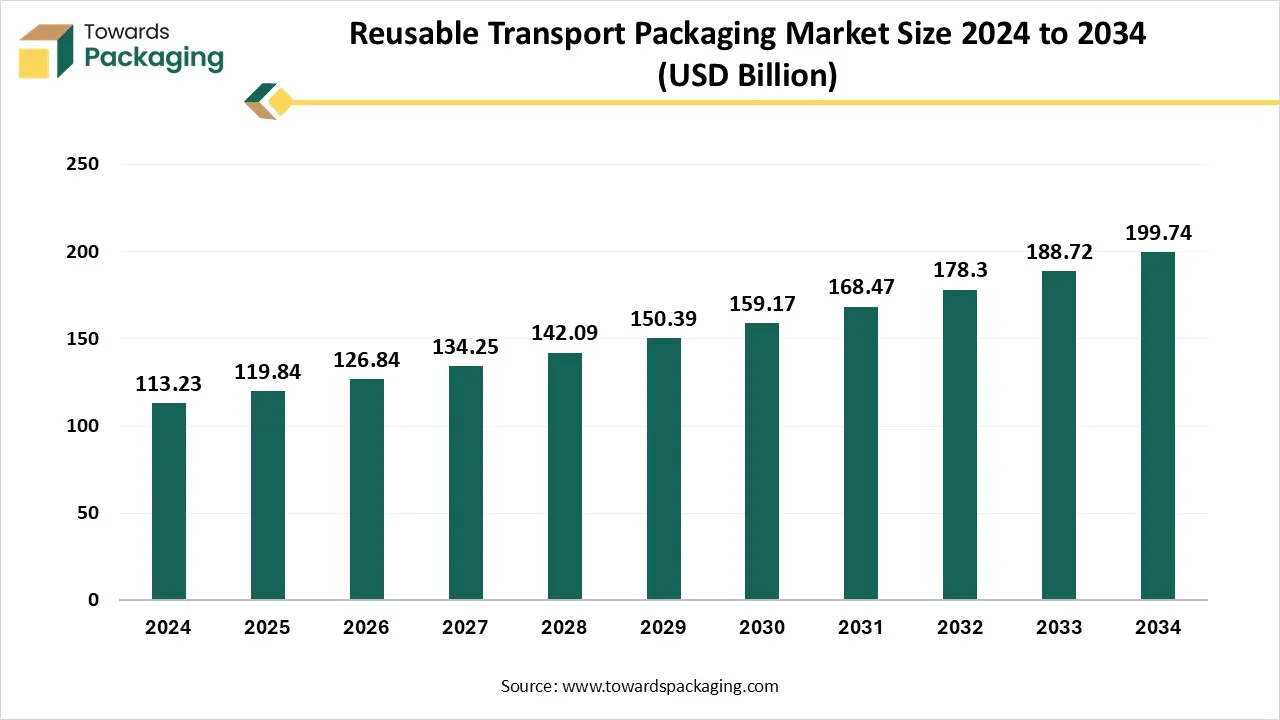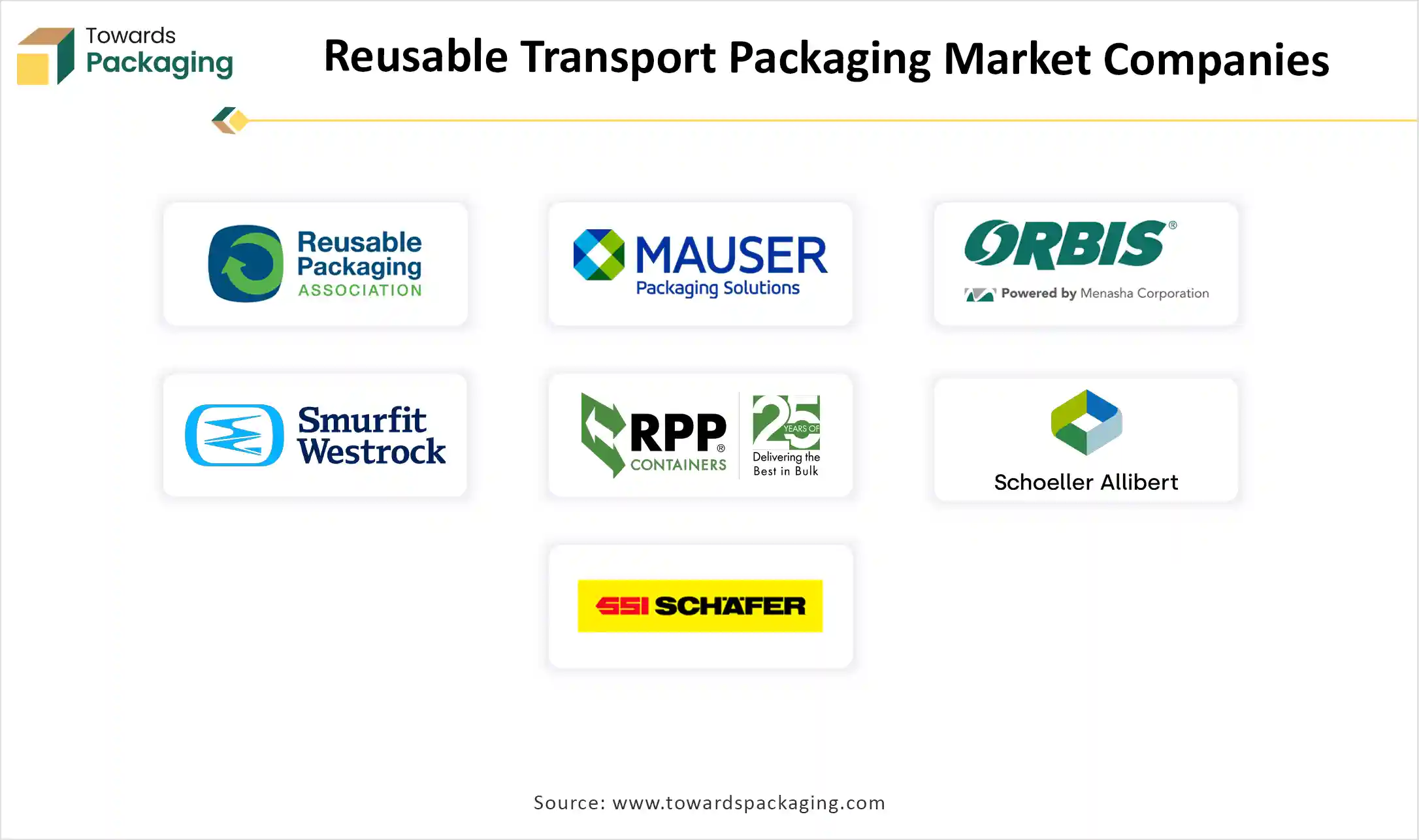October 2025
The reusable transport packaging market is forecasted to expand from USD 119.84 billion in 2025 to USD 199.74 billion by 2034, growing at a CAGR of 5.84% from 2025 to 2034.This market is growing because the stringent government regulations worldwide, the challenge of global warming due to excessive CO2 emissions, single-use packaging waste management issues, and technological improvements in the packaging item return mechanism, all of which are driving the growth of the reusable packaging market. the market has huge potential in the upcoming times as environment-related awareness has increased throughout the world.

An increase in packaged food, e-commerce, retail shopping, and other packaging applications has surge in the use of single-use packaging, which is also generating an enormous amount of waste. Annually, 400 million tons of waste is generated due to the use of single-use plastic. This is creating a huge waste management challenge for the authorities, and an adverse impact on marine life due to improper waste management is becoming uncontrollable. The increasing CO2 emissions are leading to climate change and irregularities in monsoon, and the greenhouse effect has increased the temperature of the Earth.
These packaging solutions are made from very durable materials such as plastic, wood, glass, metal, rubber, and composite materials etc. One of the key advantages of reusable transport packaging is observed in improved supply chain efficiency due to reduced waste management. The reusable transport packaging solutions are very cost-effective, the initial investment can be slightly higher, but in a very short time, the cost is recovered, and then it's almost free of cost for a very long time. All these factors are driving the reusable transport packaging market, and it is presumed to become a very common practice in all sectors in the near future.
| Metric | Details |
| Market Size in 2024 | USD 113.23 Billion |
| Projected Market Size in 2034 | USD 199.74 Billion |
| CAGR (2025 - 2034) | 5.84% |
| Leading Region | North America |
| Market Segmentation | By Material, By Packaging Type, By End Use and By Region Covered |
| Top Key Players | Smart Crates, Schoeller Arca Systems, Reusable Packaging Group, Polymer Logistics, Reusable Transit Packaging |
AI is completely changing the reusable transport packaging market game with its live inventory management systems, with just a click away, manufacturers can immediately know about the shipments available inside a depot. They can know its origin and destination with just a click without any need for manual intervention. The QR code and RFID tags help identify the container and can be tracked throughout the transportation. The AI integration in the supply chain management helps in providing valuable consumer behavior insights based on which shipments can be prescheduled. The market can be dynamic and stays volatile all the time, AI with dynamic product pricing can adjust the product pricing as per the market conditions for effective sales.
Reusable transport packaging has many challenges, such as logistics and tracking of the containers, reverse logistics infrastructure, washing, and maintenance, utilization of storage space in the most effective manner, low return rates, and complex issues in supply chain management, etc. These issues can be dealt with effectively by AI integration.
The AI-driven tracking systems can choose the most effective route available at the current time, it can schedule and handle the inventory for proper collection, transportation, and redistribution of containers. Live tracking of the container is possible due to the QR codes and RFID tags, and it can be handled properly. Return of the container after use is a challenging task. AI is helping to manage the container return infrastructure, washing, and maintenance, etc., and effective usage of available space, and ensuring the highest return rate by enabling a convenient return mechanism.
The logistics provider's strategic partnership is turning out to be very efficient and cost-effective because the reusable transport packaging providers and logistics providers are working together by combining their unique strengths. Reusable transport packaging providers are bringing their unique expertise, where they are specifically focused on the quality of container manufacturing and their core business operations.
The logistics providers are taking care of the transportation, washing, and return logistics. This approach reduces the unnecessary burden on the reusable transport packaging providers, and they can focus on their core operations. The other activities, such as return logistics operations, can be outsourced to the logistics providers.
Globally, governments are imposing a ban on single-use plastic packaging. The only feasible solution for this challenge is to shift towards the reusable transport packaging solution, considering the sustainable growth. Single-use plastics have generated massive waste, which is polluting the water bodies and fertile land, causing losses to the economy in the long term. The government has pushed the companies towards implementing sustainable solutions. Reusable transport packaging has helped companies save the cost of waste management, which is an additional benefit.
QR codes and RFID tags have enabled live tracking of the containers, supplier can track the shipments, which shipment is at which place at present. Integration with IoT sensors allows tracking the temperature of the containers to manage the perishable items effectively.
Enhancement in the security seals, such as tamper-proof seals, is very helpful in tampering detection and maintaining product integrity. Reinforced plastics, composite materials, and sustainable metals create lightweight and highly durable reusable transportation containers. The latest enhanced barrier solutions developed using nanotechnology and the antimicrobial properties have made the packaging quality standards very high and increased the product shelf life.
High strength and durability, while being a lightweight material, make the plastic a very popular material in the reusable transport packaging market. it is highly water resistant, rust-proof, and very strong and rigid, unlike the wood and metal containers. It is available in an adequate amount for the production of high-quality containers. Metal is used in significant amount due to it high strength and material longevity. The initial cost is slightly higher in the metal containers ,barrels etc, but they are capable of transporting liquids, high pressure gases and other materials effectively.
Pallets are flat structures made using plastics, wood, or metal. Pallets are extremely essential for transport packaging; they act as a portable platform for moving the goods. The efficient cargo transition facilitators for the loading and unloading of goods. They help in the supply chain for handling large quantities of goods and materials.
Currently, they are dominating the market and showing continuous growth. Dunnage & cargo protection is the fastest-growing product due to the increasing requirement for cargo protection and safety. One of the key reasons behind its increasing demand is the rise of e-commerce. Various fragile items, delicate electronic devices, are transported regularly, which requires higher safety during transportation.
Increasing demand for food and beverages due to their rising consumption has made it the dominating end-use segment in the reusable transport packaging. During transport, the food and beverages need to be handled at the proper temperature and in proper hygienic conditions. Daily consumption of milk and other items such as vegetables, bread, etc., requires proper containers to store them without any damage during transportation. Followed by the food and beverages, the consumer goods are the fastest growing due to their heavy demand. FMCG, electronics, furniture, etc, are in high demand due to rising population, people shifting towards urban cities, and various other factors.
The North American market has adopted reusable transport packaging on a large scale, with the key drivers in the North American market for the reusable transport packaging being the rising e-commerce, stringent government regulations, raised awareness for environmental concerns, and waste management challenges. Corporate initiatives towards carbon neutrality and a zero-carbon mission are boosting the reusable transport packaging demand. Technological improvements I the management of reusable containers with QR and RFID technologies have become very convenient to handle due to AI integration in the container return mechanism and tracking facility. These factors are driving the market growth in the North America region.
The European region is regulated by government regulations, which ensure the implementation of sustainable packaging solutions. The European economy has adopted the circular economy model, where the main focus is on the reusability and recyclability of packaging products.
Packaging and Packaging Waste Directives declared by the EU mandate the states to implement various solutions for packaging and packaging waste reduction. Other initiatives, such European Green Deal, are ensuring the reusage of packaging and the implementation of the circular economy initiatives.
Consumer awareness regarding sustainable packaging in the European population is very high. People make conscious choices for the brands and products that are adopting eco-friendly practices. Businesses in the European region are actively adopting reusable packaging solutions while focusing on new technological innovations. All these factors are contributing to the global dominance of the European region in the reusable transport packaging market
Rapidly growing E-commerce in the Asia-Pacific region, shift towards circular economy, and the waste management challenges of single-use transport packaging have started the market to shift towards reusable transport packaging in the Asia-Pacific region. Government regulations on single-use packaging are pushing industries towards reusable packaging solutions. Industries are also actively moving towards reusable transport solutions as they are turning out to be more cost-effective and reducing the waste management challenge.
Improved technology in material sciences and logistics monitoring has made it very easy to implement the reusable transport packaging operations with utmost efficacy and seamlessness. This market is expected to grow exponentially, considering its immense potential.

By Material
By Packaging Type
By End Use
By Region Covered
The global packaging resin market size to rise from US$ 273.42 bn in 2025 to US$ 386.19 bn by 2030. Asia Pacific dominated the packaging resin market ...
October 2025
October 2025
October 2025
October 2025